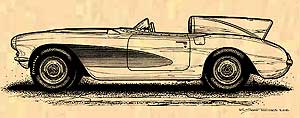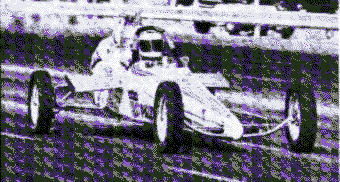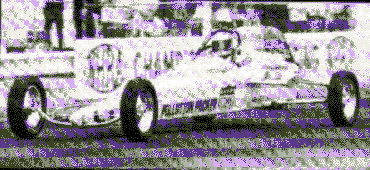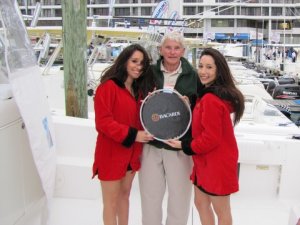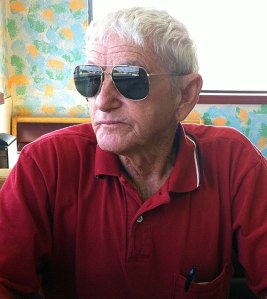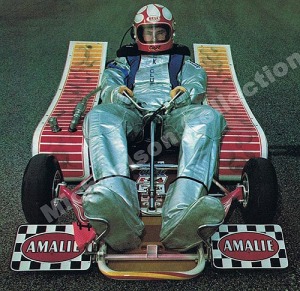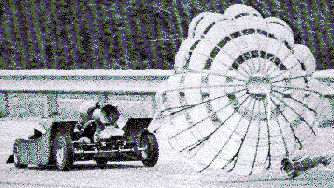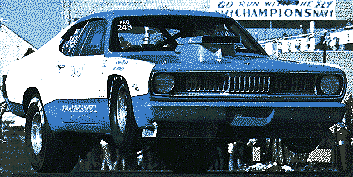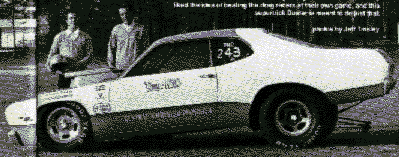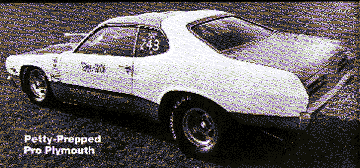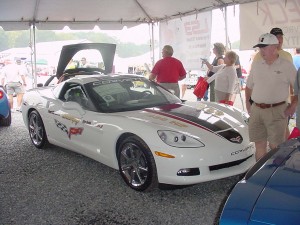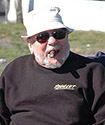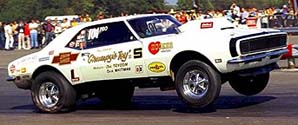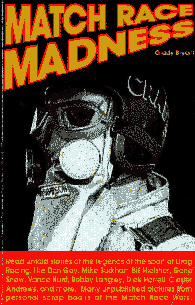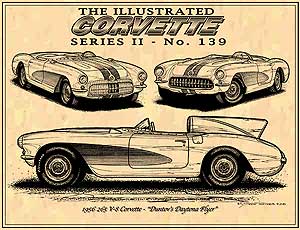 Illustrated Corvette Series No. 139 1956 Corvette
Illustrated Corvette Series No. 139 1956 Corvette
By K. Scott Teeters
Story-
“Zora Arkus-Duntov’s Daytona Flyer-The First Factory Supported Racing Corvette”
By K. Scott Teeters
Now that the ’09 ZR1 is finally in the hands of customers, I thought it would be fun to take a look back at the first factory-supported racing Corvette. The ZR1 is a wonder of aluminum, titanium, carbon fiber, and computers. By contrast, the ‘56 Daytona Speed Weeks Corvette was born of cast iron, steel, fiberglass, and pure guts.
Appearance aside, the first-generation Vette was far from a true sports car. The car’s steel perimeter frame was essentially the same as that of a regular Chevy sedan. What wasn’t obvious before Duntov started pushing the car’s performance was that without a steel body, the Corvette was rather flexible. When pushed hard in corners, the car understeered heavily and was challenging to control. Thanks to friends in high places in GM—namely, Ed Cole and Harley Earl—and the arrival of the ‘55 Thunderbird, the Corvette was given a second chance for ’56 with a completely restyled body. Clearly, the stylists were influenced by the stunning ‘54 Mercedes 300SL. The new design had forward-leaning front fenders, regular headlights, a cleaned-up tail section, and Mercedes-like hood bulges. Chevy’s 265ci V-8, new in ‘55, gave the Corvette a much-needed power boost.
To demonstrate the new V-8’s capabilities, Duntov drove a specially prepared ‘56 Chevy in the Pikes Peak hillclimb event. The car turned in a record time of 17 minutes, 24.05 seconds. During a party after the event, Duntov suggested to Cole that they show the world how fast a ’57 Corvette could go. When Cole inquired as to how just how fast that was, Duntov replied that the car could perhaps touch 150 mph. Although stock examples could only hit 135 mph at the time, Cole liked the challenge and made Duntov his Corvette-racing field commander.
Duntov started off with a ‘54 Corvette as his test mule. He knew that accomplishing his goal would require two things: more power and improved aerodynamics. First, he removed the stock windshield and built a small windscreen. A tonneau cover was then added to the passenger side, and a fairing with a long fin was added to the rear deck behind the driver’s head. Calculating that the car needed an additional 30 hp, Duntov revised the V-8’s camshaft to provide the required performance boost. This was the beginning of the famous “Duntov Cam” option. All of Duntov’s tricks worked beautifully. At GM’s Phoenix test track, Duntov personally drove the mule to a top speed of 163 mph. The green light for the upcoming Daytona race was on.
A month before the big event, in January 1956, Duntov took his mule car, fitted it with ’56 body panels, and blasted the Daytona beach with a 150.583-mph run. In February, he arrived with three race-prepared Corvettes—the mule car and two slightly modified stockers—all painted white with blue stripes and side coves. The mule now had cone fairings over the headlights and taping over almost the entire front grille opening and fender vents. The other two cars were similarly equipped, with tonneau covers and taped-up fender vents. Each Vette was powered by a 265 small-block with the experimental Duntov Cam, special 10.3:1-compression heads, and an output of 255 hp. But here’s the kicker: Because they were running on packed beach sand, the cars were equipped with snow tires!
Duntov drove the mule, while former Mercedes team driver John Fitch and airplane racer Betty Skelton drove the two other cars. There were two parts to the event: standing-mile acceleration and top speed. Ford and Chevy were in the midst of a speed war at the time. The Ford entry was Chuck Dalgh’s modified Thunderbird. In the standing mile, Fitch’s Corvette came in Third behind Dalgh’s 86.872-mph T-Bird. Duntov, meanwhile, was the fastest in the modified class with a 89.753-mph run. But the real bragging rights were reserved for the top-speed event. The Dalgh T-Bird didn’t compete in the top-speed runs, and the Corvettes romped. Fitch won the production-sports-car class with a top speed of 145.543-mph, and Skelton came in Second with a 137.773-mph run. Duntov had the fastest time in the modified class with a 147.300-mph run. It should be noted that there were strong headwinds at Daytona that kept the Corvettes from passing the 150-mph mark.
The event was so successful, GM gave Duntov the go-ahead to build three more cars for the 12-hour Sebring race, just six weeks after Daytona. John Fitch was assigned the unrealistic task of preparing the cars. While the Corvettes performed well under their potential at Sebring, they managed to finish their first sports-car competition and set the stage for bigger things to come. A print ad showed one of the Sebring cars in the pits, dirty and race-worn, with the driver exiting the cockpit. The headline read, “The Real McCoy.” And that’s how the Corvette racing legend began.
Go to www.illustratedcorvetteseries.com to purchase the artwork and for more great Corvette stories and art.
